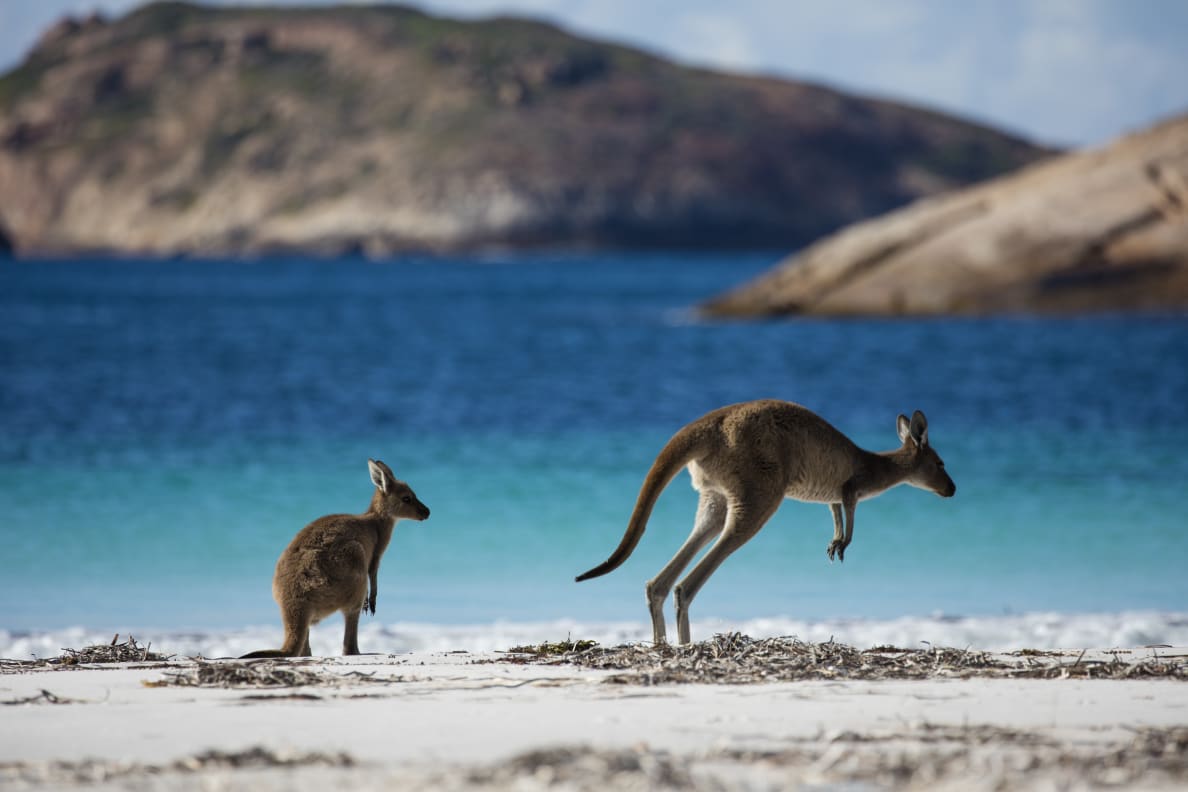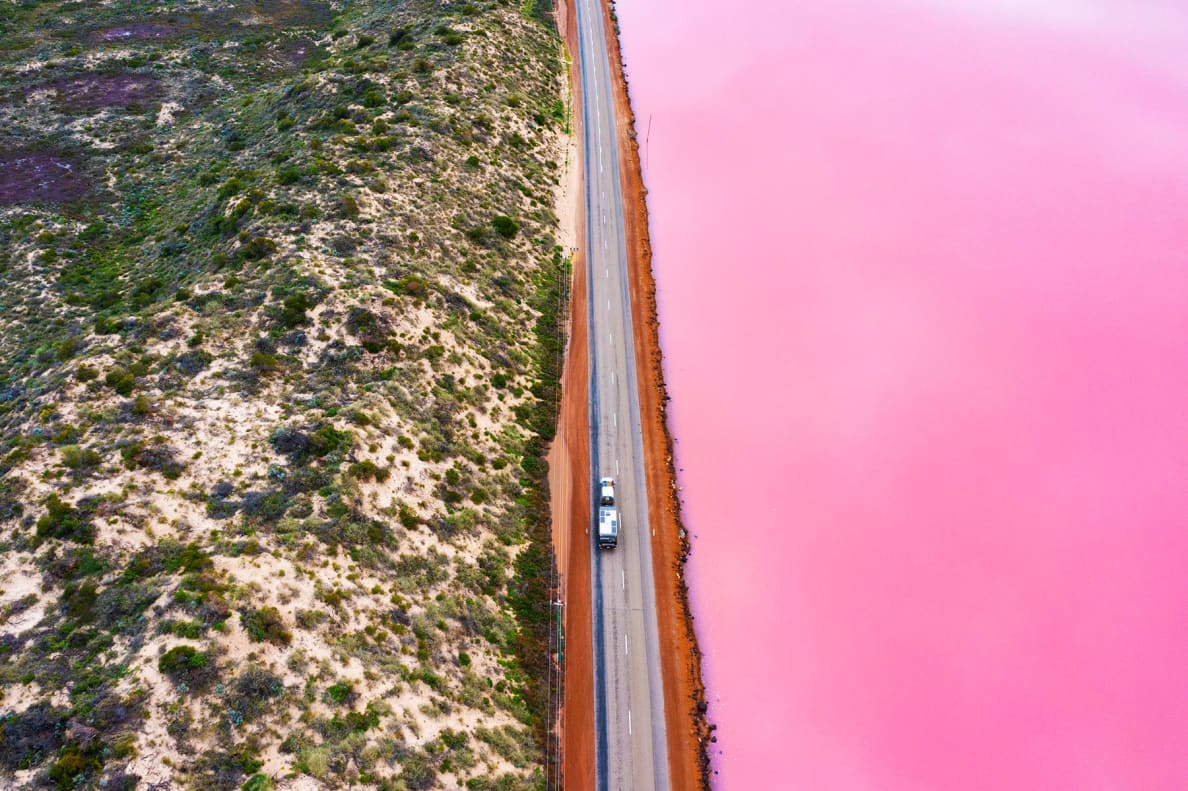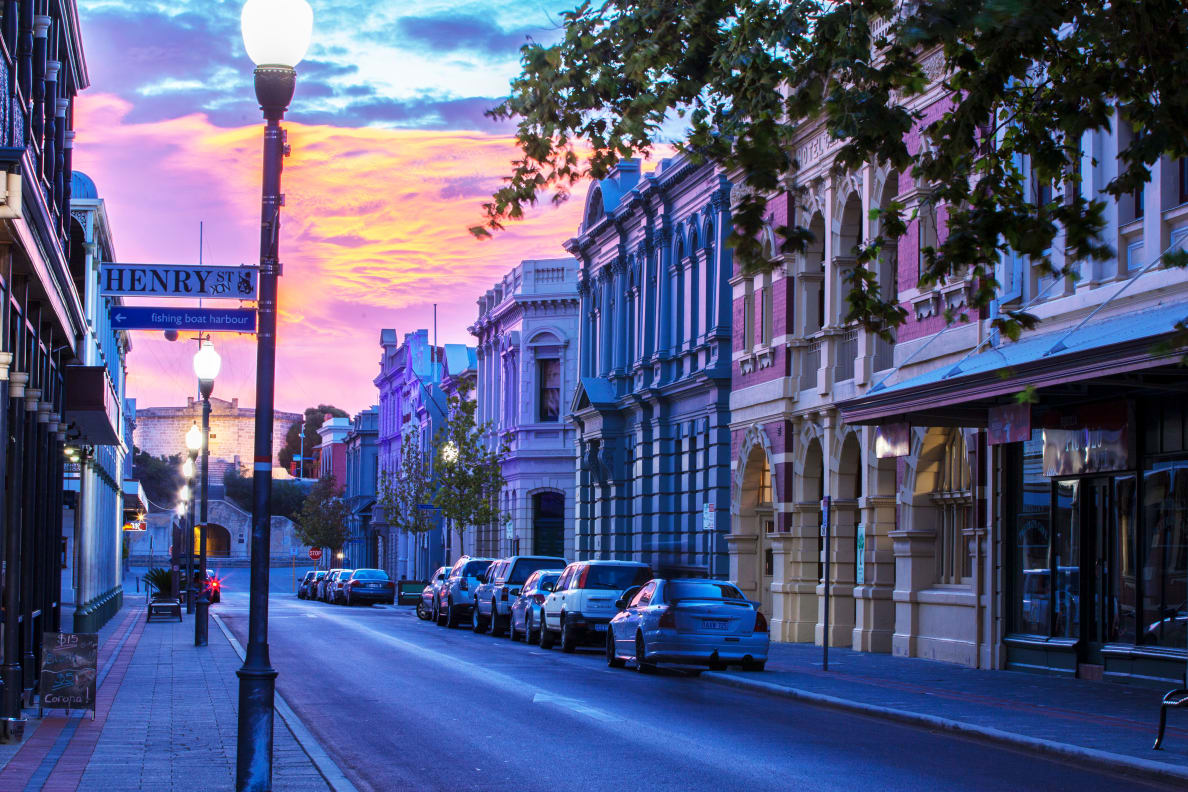To see how the other half lives–even just for a week–is the juicy lure of luxury travel. You might not be able to afford a yacht, but you can charter one. You don’t have a mansion on the sea with servants, but for a grand a night you can stay somewhere that makes you feel like you do. But what about seeing how only 0.03 percent of the world’s population gets to live–in a place with paradisiacal nature, some of it virtually prelapsarian, but with all the 21st century comforts? That, after all, is life for those who live in one of the most remote places on Earth, southwestern Australia. This spring (their fall), I had the fortune to explore a sliver of this massive region. I swam at beaches of sparkling white sand where wild kangaroos can be your only company, soared above rainbow-hued lakes, delved into unfamiliar history, devoured delicious food, and soaked up wine from top-notch vineyards.
Nearly a decade ago, I visited Perth on a whim and did the classic itinerary of Rottnest Island, Margaret River, and a little of the city of Perth itself. This time, I flew to the other corner of the globe (five hours to San Francisco, fifteen to Sydney, five more to Perth) to explore a different portion of Western Australia–Esperance–as well as other parts of Perth.

Kangaroos at Lucky Bay, Cape La Grand National Park
Tourism Western Australia
Sunny, mild weather greeted me as I exited the airport. After a quick nap at my centrally located hotel, the QT Perth, I joined Two Feet & a Heartbeat for a mini-walking tour. This being Australia, we quickly found ourselves in a pub–Foxtrot, a polished wood and taxidermied foxes kind of place–where stories of Perth’s steady rise since the gold rush were peppered in around drinks. While a corporate town in many ways, Perth is relatively laid back. That being said, those seeking a night where things are a little more sceney all seemed to be gathered at the QT Perth’s signature restaurant, Santini Bar & Grill, where I dined before crawling into bed.
Modern medicine procured at a pharmacy in Mexico ensured a full night of sleep, and on my morning run I was aware enough to notice that the streets of the city’s core were full. I’m all for remote work, but as a visitor, it was delightful to see a city thrumming like that. I refueled at Coee Perth, a cafe along the Swan River, and then toured around King’s Park, one of the world’s largest urban parks. It’s filled with bush trails, gum tree-lined drives, and golf-course level lawns. And it and overlooks the skyline of the still-growing city of more than two million.
One area of tourism Australia is keen to build out these days is any experience that taps into Aboriginal culture. If your first reaction to spending part of your hard earned vacation on something that seems a little “eat your peas,” just an hour spent with Dale Tillbrook at Mandoon Estate will disabuse you of that. The story of Aboriginal people in southwestern Australia is an incredibly rich, albeit dark, tale. But Tillbrook weaves those stories in while you explore the foods these cultures cultivated long before Europeans arrived. You’ll try youlk, which is like carrot with a hint of pear, and greedily sniff ground up roasted wattleseed, which is like a mix of hazelnut and coffee. You get to sample all manner of limes, and gobble up sandalwood nuts while marveling that our obsession with the scent of its trees meant these delicious things have long been overlooked.
Esperance can be found in the center of Western Australia’s southern coast, at the water’s edge of one of those green patches that fringe Australia’s vast and merciless interior. Driving there is possible, but REX (Regional Express) flies daily from Perth, where the regional terminal is full of men and women in blue, orange, and lime jumpsuits. They’re FIFOs, as in fly-in-fly-out, and there’s something a little surreal being confronted as a leisure tourist with people quite literally “off to the mines.”

Tourism Western Australia
The flight is roughly an hour and fifteen minutes on the twin-prop plane and then it’s a quick drive (you’ll need to rent a car) to town. My home for the few days was the Esperance Chalet Village, a collection of cute A-frames and cabins clustered near horse farms along the Bandy Creek. If you’re somebody who wakes in the night to pee (or have a messed up body clock from jet lag), go for one of the cabins as the bedroom in the A-frame is lofted. The town itself is about a five-minute drive away and an odd mix of things. It’s immaculately clean with a dreamy esplanade lined with Norfolk pine that looks out onto the Recherche Archipelago offshore. The infrastructure is thoroughly modern, but the buildings lining them look more like something out of a frontier town–some sturdy, some flimsy. Looming over–and in stark contrast to–all this charm is the tanker terminal where the ore and grain from the interior arrives on rail before being shipped to sate the modern world.
My first meal in town was gummy shark at Loose Goose, a long-running local spot. It was served in a garlic and chive sauce over mashed potatoes and was all the superlatives one uses when describing a tasty fish. (Sadly, the apple crumble I finished with wasn’t equally top notch). Given that Esperance is only about 14,000 people and extremely remote, it’s remarkable how well I ate while there. Those craving straight from the garden fare can head outside of town to Yirri Grove, an olive oil farm where Shane and Anne O’Neill host visitors for lunch pulled straight from their gardens. The view from their dining shed is an unobstructed one of rolling farm and natural bushland, and the couple are straight out of central casting for charming farm couple. Convinced for some reason that mechanical aptitude lay buried deep within me, Shane even naively tried to talk me through reassembling their olive press. For breakfast, you can’t go wrong at Cloud Eleven, a family-run cafe and eatery where you’ll encounter the classic Australian obsessiveness about coffee. For something more upscale, there’s Taylor St. Quarters on the water. And for families, it doesn’t get much better than Lucky Bay Brewing, where classic pub fare is served overlooking a sprawling lawn with playsets for kids.

Tourism Western Australia
Esperance has a couple of big draws, and one of them was always its pink lake. Now, whether it’s the fault of the rail tracks put in alongside it interfering with the natural process—which seems to be the consensus—or not, Lake Hillier outside Esperance is no longer pink. But those keen to observe this freak quirk of nature where the interplay of salt and algae created multi-hued lakes aren’t out of luck. They just need to get up in the air, because the farmlands to the north of town have dozens of these pools resembling opalescent contact lens cases. To go up and see them, you need to book a tour with Tour Esperance, which also runs the 4×4 experience along the vast stretches of Cape Le Grand’s sandy beaches. It’s with Tour Esperance that you have a shot at sipping tea with kangaroos on Lucky Bay Beach, recently named the best in the world. The water there is famed for its clarity and cars can drive right onto its squeaky (because of high amounts of silica) snow-like sand. It’s a bit like being picky when confronted with a bunch of supermodels, but the area’s most spectacular beach in my view is neighboring Hellfire Bay, a tight curve of a white sand beach with electric blue water.
The whole area is an embarrassment of riches. While you need a 4×4 to drive on the beaches, any car will suffice on Esperance’s famed Great Ocean Drive. It’s a 40 kilometer ribbon of a road running parallel to the dramatic coastline. There are stretches where the waves smash perilously into coffee-colored cliffs and others with beaches great for surfing and swimming–like Twilight or Blue Haven. Plus, there are trails for biking, hiking, and jogging.
It’s more of a bump really, than a peak, a round protrusion of granite covered millions of years ago by white, gray, and pink crystals. It no longer sparkles, and it isn’t pointy, but at sunrise the summit of Frenchman’s Peak is the spot to watch Cape Le Grand National Park come alive. It’s not a hard climb—20 to 40 minutes depending on your fitness. Driving into the park in the hour before sunrise might be the hardest part of the whole endeavor. You spend it tensely gripping the wheel on the alert for a nonchalant kangaroo in the middle of the road. While the view from atop is astounding, more so is that you’ll likely have it to yourself. Flabbergasted is the word that comes to mind at the idea that a signature sunrise hike in a top-notch national park could be done in total solitude. Only adding to that sense was after hiking I popped down to Hellfire Bay for a cool off swim. Again, all alone. But that’s travel in Western Australia.
I spent my final night in the region in one of the continent’s most historic cities–Fremantle, which sits at the mouth of the Swan River and is part of greater Perth. The region’s original port city, it’s a rarity among Australian cities in that much of its historic Victorian architecture is startlingly intact. Indeed, hanging on the restored walls of the National Hotel on the town’s movie set main drag is an aerial shot of the city a century ago alongside a contemporary one and little has changed. Like Charleston, South Carolina, Fremantle was preserved largely because it was left behind economically a century ago. In this case, everything moved upriver to Perth, leaving behind block after block for artists, bohemians, as well as rougher elements of society.

It has since been partially gentrified–I spent the night in the Warders Hotel, which used to be the quarters for the warders of the city’s terrifying prison. My guide for a walking tour up and down its streets was the bubbly Adie Chapman of tour operator Oh Hey WA. As a temporary interloper, I can’t speak to the fights this town is having about its identity, but I found it a magical mix of galleries, sex shops, dive bars, tourist traps, clubs pubs, and cutting edge restaurants–still savoring that spicy but to-die-for Massaman beef curry at Emily Taylor and the mushroom overload risotto at Vin Populi.
Belly swollen (I haven’t entirely lost the urge to overeat coming from a big family), I walked home that night. My mind drifted, and I was brought back to being in that little plane buffeted about in the firmament of Esperance. Small planes are often a white-knuckle event for me, but there was something about seeing those pristine beaches and lakes that would be overrun anywhere else in the world so empty. Even though it’s far, the ability to experience places in that way these days is, as they say, priceless. So, I’ll be back.
